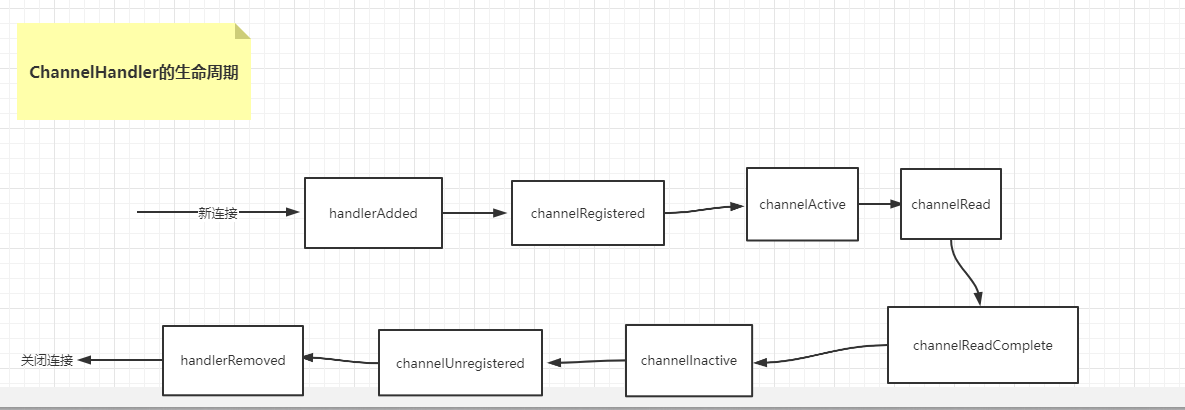

Netty 学习(四):ChannelHandler 的事件传播和生命周期 - Grey Zeng
source link: https://www.cnblogs.com/greyzeng/p/16709462.html
Go to the source link to view the article. You can view the picture content, updated content and better typesetting reading experience. If the link is broken, please click the button below to view the snapshot at that time.

Netty 学习(四):ChannelHandler 的事件传播和生命周期
作者: Grey
原文地址:
博客园:Netty 学习(四):ChannelHandler 的事件传播和生命周期
CSDN:Netty 学习(四):ChannelHandler 的事件传播和生命周期
ChannelHandler 的事件传播#
在通信客户端和服务端,处理的流程大致有如下步骤
输入---> 解码 ---> 根据不同的消息指令解析数据包 ---> 编码 ---> 输出
在『根据不同的消息指令解析数据包』这个步骤中,经常需要用if-else来判断不同的指令类型并进行解析。逻辑一旦复杂,就会让代码变的极为臃肿,难以维护。
Netty 中的 Pipeline 和 ChannelHandler 就是用来解决这个问题,它通过责任链设计模式来组织代码逻辑,并且能够支持逻辑的动态添加和删除。
在 Netty 框架中,一个连接对应一个 Channel,这个 Channel 的所有处理逻辑都在 ChannelPipeline 的对象里,ChannelPipeline 是双向链表结构,它和 Channel 之间是一对一的关系。这个双向链表每个节点都是一个 ChannelHandlerContext 对象,这个对象可以获得和 Channel 相关的所有上下文信息。
示例图如下
ChannelHandler 包括两个子接口:ChannelInboundHandler 和 ChannelOutboundHandler,分别用于处理读数据和写数据的逻辑。
我们可以写一个示例来说明 ChannelHandler 的事件传播顺序(包含 ChannelInboundHandler 和 ChannelOutboundHandler)
在服务端配置如下
ch.pipeline().addLast(new InHandlerA());
ch.pipeline().addLast(new InHandlerB());
ch.pipeline().addLast(new InHandlerC());
ch.pipeline().addLast(new OutHandlerA());
ch.pipeline().addLast(new OutHandlerB());
ch.pipeline().addLast(new OutHandlerC());
其中 InHandlerA 代码如下(InHandlerB 和 InHandlerC 类似)
package snippet.chat.server.inbound;
import io.netty.channel.ChannelHandlerContext;
import io.netty.channel.ChannelInboundHandlerAdapter;
/**
* @author <a href="mailto:[email protected]">Grey</a>
* @date 2022/9/19
* @since
*/
public class InHandlerA extends ChannelInboundHandlerAdapter {
@Override
public void channelRead(ChannelHandlerContext ctx, Object msg) throws Exception {
System.out.println("in-A:" + msg);
super.channelRead(ctx, msg);
}
}
OutHandlerA 代码如下(OutHandlerB 和 OutHandlerC 类似)
package snippet.chat.server.outbound;
import io.netty.channel.ChannelHandlerContext;
import io.netty.channel.ChannelOutboundHandlerAdapter;
import io.netty.channel.ChannelPromise;
/**
* @author <a href="mailto:[email protected]">Grey</a>
* @date 2022/9/19
* @since
*/
public class OutHandlerA extends ChannelOutboundHandlerAdapter {
@Override
public void write(ChannelHandlerContext ctx, Object msg, ChannelPromise promise) throws Exception {
System.out.println("out-A:" + msg);
super.write(ctx, msg, promise);
}
}
运行服务端和客户端,使用客户端向服务端发送一些数据,可以看到如下日志
in-A:PooledUnsafeDirectByteBuf(ridx: 0, widx: 108, cap: 2048)
in-B:PooledUnsafeDirectByteBuf(ridx: 0, widx: 108, cap: 2048)
in-C:PooledUnsafeDirectByteBuf(ridx: 0, widx: 108, cap: 2048)
......
out-C:PooledUnsafeDirectByteBuf(ridx: 0, widx: 39, cap: 256)
out-B:PooledUnsafeDirectByteBuf(ridx: 0, widx: 39, cap: 256)
out-A:PooledUnsafeDirectByteBuf(ridx: 0, widx: 39, cap: 256)
由此可以知:inboundHandler 的添加顺序和执行顺序一致,而 outboundHandler 的添加顺序和执行顺序相反。 如下图示例
ChannelHandler 的生命周期#
可以用代码来说明 ChannelHandler 的生命周期,我们基于 ChannelInboundHandlerAdapter,定义了一个 LifeCycleTestHandler,完整代码如下
package snippet.chat.client;
import io.netty.channel.ChannelHandlerContext;
import io.netty.channel.ChannelInboundHandlerAdapter;
/**
* @author <a href="mailto:[email protected]">Grey</a>
* @date 2022/9/19
* @since
*/
public class LifeCycleTestHandler extends ChannelInboundHandlerAdapter {
// 这个回调方法表示当前Channel的所有逻辑处理已经和某个NIO线程建立了绑定关系,接收新的连接,然后创建一个线程来处理这个连接的读写,只不过在Netty里使用了线程池的方式,
// 只需要从线程池里去抓一个线程绑定在这个Channel上即可。这里的NIO线程通常指NioEventLoop
@Override
public void channelRegistered(ChannelHandlerContext ctx) throws Exception {
System.out.println("channel 绑定到线程(NioEventLoop):channelRegistered()");
super.channelRegistered(ctx);
}
// 这个回调表明与这个连接对应的NIO线程移除了对这个连接的处理。
@Override
public void channelUnregistered(ChannelHandlerContext ctx) throws Exception {
System.out.println("channel 取消线程(NioEventLoop)的绑定:channelUnregistered()");
super.channelUnregistered(ctx);
}
// 当Channel的所有业务逻辑链准备完毕(即Channel的Pipeline中已经添加完所有的Handler),
// 以及绑定好一个NIO线程之后,这个连接才真正被激活,接下来就会回调到此方法。
@Override
public void channelActive(ChannelHandlerContext ctx) throws Exception {
System.out.println("channel 准备就绪:channelActive()");
super.channelActive(ctx);
}
// 这个连接在TCP层面已经不再是ESTABLISH状态了。
@Override
public void channelInactive(ChannelHandlerContext ctx) throws Exception {
System.out.println("channel 被关闭:channelInactive()");
super.channelInactive(ctx);
}
// 客户端向服务端发送数据,每次都会回调此方法,表示有数据可读。
@Override
public void channelRead(ChannelHandlerContext ctx, Object msg) throws Exception {
System.out.println("channel 有数据可读:channelRead()");
super.channelRead(ctx, msg);
}
// 服务端每读完一次完整的数据,都回调该方法,表示数据读取完毕。
@Override
public void channelReadComplete(ChannelHandlerContext ctx) throws Exception {
System.out.println("channel 某次数据读完:channelReadComplete()");
super.channelReadComplete(ctx);
}
// 表示在当前Channel中,已经成功添加了一个Handler处理器。
@Override
public void handlerAdded(ChannelHandlerContext ctx) throws Exception {
System.out.println("逻辑处理器被添加:handlerAdded()");
super.handlerAdded(ctx);
}
// 我们给这个连接添加的所有业务逻辑处理器都被移除。
@Override
public void handlerRemoved(ChannelHandlerContext ctx) throws Exception {
System.out.println("逻辑处理器被移除:handlerRemoved()");
super.handlerRemoved(ctx);
}
}
我们在服务端添加这个 Handler,然后启动服务端和客户端,可以看到服务台首先输出如下日志
逻辑处理器被添加:handlerAdded()
channel 绑定到线程(NioEventLoop):channelRegistered()
channel 准备就绪:channelActive()
channel 有数据可读:channelRead()
Mon Sep 19 22:49:49 CST 2022: 收到客户端登录请求……
Mon Sep 19 22:49:49 CST 2022: 登录成功!
channel 某次数据读完:channelReadComplete()
由日志可以看到,ChannelHandler 执行顺序为:
handlerAdded()->channelRegistered()->channelActive()->channelRead()->channelReadComplete()
关闭客户端,保持服务端不关闭,在服务端此时触发了 Channel 的关闭,打印日志如下
channel 被关闭:channelInactive()
channel 取消线程(NioEventLoop)的绑定:channelUnregistered()
逻辑处理器被移除:handlerRemoved()
如上述日志可知,ChannelHandler 的执行顺序是
channelInactive()->channelUnregistered()->handlerRemoved()
整个 ChannelHandler 的生命周期如下图所示
图例#
本文所有图例见:processon: Netty学习笔记
代码#
更多内容见:Netty专栏
参考资料#
Recommend
About Joyk
Aggregate valuable and interesting links.
Joyk means Joy of geeK


